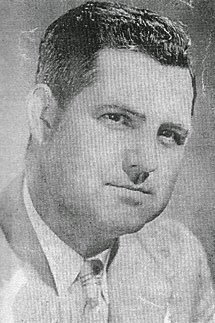Though I don't have any hard evidence yet to back it up, I've been told that Papa
Gilmer was one of the first presidents and a charter member of the Lamar County Farm Bureau (now Lamar County Farmers Federation).
My grandfather, Gray
Gilmer, had left the farm and his own fledgling egg
business in the early 1930's to take a job with the TVA. He built dams all along the Tennessee River, starting first as a common laborer at Pickwick. He continued with the TVA through the Great Depression and World War II, rising through the ranks as a carpenter and ultimately holding the position of safety engineer. Following the construction of
Fontana Dam he took a similar position with
USF&G Insurance's
Kingsville, TN affiliate. As my grandmother states in her book,
"Gray loved his work with USF&G. They valued his judgement and gave him many good perks. I would wonder why he couldn't just be satisfied and forget that dream he'd always retained through the years - that of coming back to the family farm in Lamar County, Alabama."
 |
| Gray Gilmer |
If coming back to the family farm was his dream, he fulfilled it about a year after his parents died. He planted his first corn and cotton crop in the spring of 1951 and started our dairy on a limited basis the following summer. After a couple of years he realized that the dairy provided a more stable source of income than did crop production on hilly, marginal ground and made that the main focus of the farm. He continued to grow crops to feed the livestock and raised hogs and chickens for the family's own consumption. Gray was a "Master Farmer Award" recipient and a long serving president and board member of the county's Farm Bureau. Above all else, he was a very dedicated, hard worker.
Though he was already semi-retired, Gray's farming career ended for good when he suffered a massive stroke in 1983 that
debilitated his speech, personality, and general health. My little sister and I, the youngest of his nine
grand kids, have no
remembrance of him before that tragic event. Perhaps that was a blessing, as Lydia and I grew up with what I felt was little difficulty communicating and interacting with our "Daddy G". I spent
a lot of time at the farm and at their house as a kid, and many of my childhood memories center around time spent with him watching an afternoon Chicago Cubs game on
WGN, sitting in a
lawnchair in the front yard looking out at the fields across from his house, or his amusement at watching this youngster get frustrated trying to herd full-grown
holsteins into the milking barn.
I'll never forget the early morning I was awoken by a knock on my door and my mother shared the news that Daddy G had passed away. He had been complaining of chest pains and my grandmother phoned for my father to come over to help get him into the car for a trip to the emergency room. A massive heart attack suffered as dad was helping him to the car claimed his life in the early morning hours of April 15, 1994. I'll never forget the disbelief I felt when my mom broke the news, or the look of stunned, defeated grief on my dad's face when I went into my grandparents house to hug my Mama G before reporting to the dairy barn less than 100 feet away for the morning milking shift. In times of both family celebration and tragedy, the dairy doesn't take a day off! Anyway, my grandfather had been in failing health leading up to his passing, but the prior day had been a "good" day. He had mowed his lawn and spent time sitting in the front yard with my grandmother, watching tractors operating in the fields in front of their house. According to my grandmother, it is just how he would have wanted to spend the last day on his beloved farm.
Switching gears from the
Gilmer family for a moment, my other grandfather was also a farmer. Linton Rhodes was a successful soybean and beef farmer in the small community of
Biggersville, Mississippi, located in
Alcorn County just a few miles south of Corinth. Mom would take my sister and I to visit my grandparents probably 5-6 times a year and they would come here about as often. Not growing up there, I don't have many farming memories of my Papa, as most of my visits involved staying around the house and playing with my cousins. He had a sense of humor and always made a show of "picking" on my grandmother around us. My last visit with him came just after I had finished my third year of college. He had since retired from row cropping, but continued to raise a few cows and did a little small-scale logging to keep himself busy. When I came to visit my grandparents he was recovering from recent gall bladder surgery and was restricted from doing anything taxing. At the same time, my grandmother was suffering from a back problem and couldn't get out much herself. As a result, we spent
a lot of time visiting and talking about nothing in particular over the course of two or three days. Just a week or two later he went out fishing one morning in the 12o-acre down the hill from his shop, never to return. His small boat toppled and he fell in the water. Still weak from his surgery and unable to swim, he was not able to free himself from the water weeds and pull himself back into the boat. A neighbor heard his cries for help, found him and pulled him from the water, but by the time
emergency personnel arrived on the scene it was too late. My Papa had passed away on Thursday, June 1, 2000.
Just as I remember my mother telling me of my father's father's death, I vividly remember the details of how I learned of my other grandfather's passing. I came in to my parent's house at lunch after a morning in the hayfield. Dad had stayed in the field and was going to take lunch once I had finished. My mom and sister were in Memphis waiting on a flight that would be the beginning of a vacation in Great Britain. Noticing the answering machine was flashing and not knowing it was
intended for my father, I pressed play (at the time we didn't carry cellphones). I heard the frantic voice of one of my grandparents' friends telling my father what had
happened as my grandmother wailed in the background. I was completely floored by that message, and can still hear it word for word, cry for cry in my head. When I came to my senses I called the travel agent to get word to my family not to board and to call home (luckily a cousin who lived in Memphis made it to the airport and delivered the sad news in person). Still in a state of mixed shock and disbelief, I went back to the field to inform dad and within an hour we were packed and headed to
Biggersville. Thankfully my Grandmother had a very strong support group of friends to help her through the ordeal, and I myself took some comfort when a family friend told me how much my Papa had enjoyed my recent visit and how proud he was of my good grades and my decision to be a farmer once I graduated college. I already had a first date with a girl lined up for that Saturday and was about to call and cancel it, but my grandmother and mother both told me that my grandfather would have wanted me to keep it. I wasn't sure how a first date only a few hours after my grandfather's funeral would work out, but nine years later we're still together, married for nearly six years with two children. We named our son David (after my father), but he goes by his middle name...Linton.
Based on the length of what I've written above about two grandfathers and a great-grandfather, I don't think I have it in me right now to talk about my own father. That will come before too long, though. Until I sit and take the time to write about all those memories, let me just leave you with this. I love farming, but it takes a back seat to working with my dad. I know it won't always be like that, but I hope we'll be able to continue working together and carrying on our family's legacy for many years to come.
















